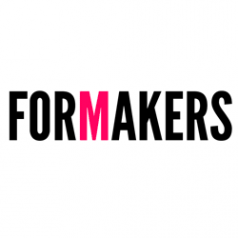03OCT 2014
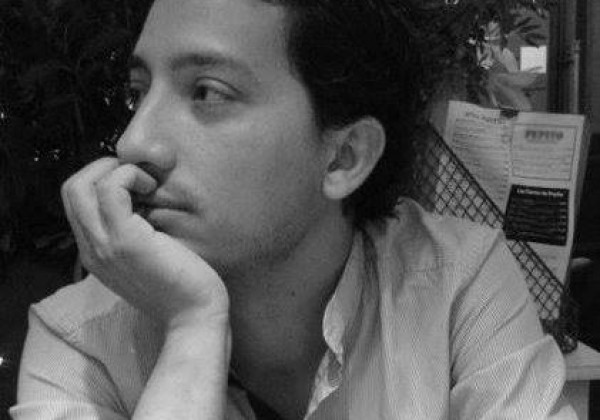 © FORMAKERS INTERVIEWS / Davide Del Giudice I am a co-founder of Co-de-iT, together with Arch.Andrea Graziano and prof.Alessio Erioli, a cluster of researchers exploring the computational design and new methods for teaching. I currently live in London and I am a Senior Architect at Zaha Hadid Architect and in my "free" time I take care of my personal projects in the field of furniture design.////////////////////////////////////////////////////////////////////////////////
2- IT: TU TI OCCUPI DI PROGETTAZIONE AVANZATA MEDIANTE L'USO DI PROGRAMMI PARAMETRICI COME RHINOCEROS, GRASSHOPPER.CI PUOI PARLARE DEL RAPPORTO TRA I SOFTWARE PARAMETRICI, IL DISEGNO PARAMETRICO, IL PROCESSO DIGITALE E LA FABBRICAZIONE DIGITALE? CHE COSA SONO E COME VENGONO APPLICATI?
I software parametrici sono la parte intelligente del disegno digitale, di solito sono sempre dei plugin di software famosi come Rhinoceros, Revit, Softimage ecc.
Li definisco intelligenti perchè ci permettono attraverso la definizione di parametri variabili e constraints di costruire degli algoritmi matematici e geometrici che ci aiutano a gestire e ad avere il pieno controllo di geometrie complesse. Il processo digitale è ciò che attualmente la maggior parte degli architetti di nuova generazione utilizza, si parte da uno sketch iniziale che può essere un semplice diagramma bisimensionale in curve NURBS oppure da una mesh prototipo fino ad arrivare a gestire i pannelli di facciata oppure i profili metallici delle strutture tramite fogli di calcolo excel. Il processo digitale è ampio e complesso, inizia dalla fase di sketch design e si conclude con la preparazione di tutti gli elaborati progettuali della fase di construction documents.
La fabbricazione digitale è un'appendice del processo digitale, con essa possiamo stampare in 3D il nostro pezzo di design o il nostro progetto in scala e viene applicata costantemente anche durante la fase progettuale come strumento di controllo del progetto stesso.
© FORMAKERS INTERVIEWS / Davide Del Giudice I am a co-founder of Co-de-iT, together with Arch.Andrea Graziano and prof.Alessio Erioli, a cluster of researchers exploring the computational design and new methods for teaching. I currently live in London and I am a Senior Architect at Zaha Hadid Architect and in my "free" time I take care of my personal projects in the field of furniture design.////////////////////////////////////////////////////////////////////////////////
2- IT: TU TI OCCUPI DI PROGETTAZIONE AVANZATA MEDIANTE L'USO DI PROGRAMMI PARAMETRICI COME RHINOCEROS, GRASSHOPPER.CI PUOI PARLARE DEL RAPPORTO TRA I SOFTWARE PARAMETRICI, IL DISEGNO PARAMETRICO, IL PROCESSO DIGITALE E LA FABBRICAZIONE DIGITALE? CHE COSA SONO E COME VENGONO APPLICATI?
I software parametrici sono la parte intelligente del disegno digitale, di solito sono sempre dei plugin di software famosi come Rhinoceros, Revit, Softimage ecc.
Li definisco intelligenti perchè ci permettono attraverso la definizione di parametri variabili e constraints di costruire degli algoritmi matematici e geometrici che ci aiutano a gestire e ad avere il pieno controllo di geometrie complesse. Il processo digitale è ciò che attualmente la maggior parte degli architetti di nuova generazione utilizza, si parte da uno sketch iniziale che può essere un semplice diagramma bisimensionale in curve NURBS oppure da una mesh prototipo fino ad arrivare a gestire i pannelli di facciata oppure i profili metallici delle strutture tramite fogli di calcolo excel. Il processo digitale è ampio e complesso, inizia dalla fase di sketch design e si conclude con la preparazione di tutti gli elaborati progettuali della fase di construction documents.
La fabbricazione digitale è un'appendice del processo digitale, con essa possiamo stampare in 3D il nostro pezzo di design o il nostro progetto in scala e viene applicata costantemente anche durante la fase progettuale come strumento di controllo del progetto stesso.
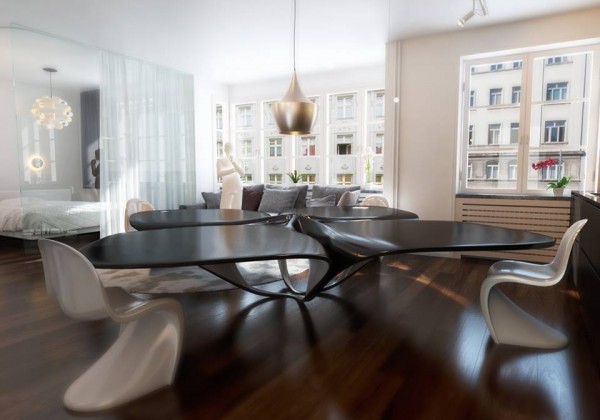 © FORMAKERS INTERVIEWS / Davide Del Giudice/////////////////////////////////////////////////////////////////////////////////////////2- EN: YOU WORK IN THE FIELD, OF THE ADVANCED DESIGN,USING PROGRAMS AS PARAMETRIC RHINOCEROS, GRASSHOPPER. CAN YOU EXPLAIN THE RELATIONSHIP BETWEEN PARAMETRIC SOFTWARE, PARAMETRIC DESIGN, PROCESS AND THE DIGITAL FABRICATION ? WHAT ARE AND HOW ARE THEY APPLIED?
The parametric software is the clever part of the digital design, they are usually plugin of software like Rhinoceros, Revit, Softimage and so on.
I call them clever because they allow us through the definition of variable parameters and constraints to build mathematical and geometric algorithms that help us to manage and have full control of complex geometries. The digital process is what is currently the most architects of new generation uses, we start from an initial sketch which can be a simple 2D diagram in NURBS curve or a mesh until you get to manage the curtain panels or profiles metallic structures using excel spreadsheets. The digital process is large and complex, begins with the sketch design phase and ends with the preparation of all project phase of construction documents.
Digital manufacturing is an appendage of the digital process, we can print it in 3D our piece of design or our project in scale and is consistently applied during the design phase as a tool of control of the project.
3- IT: QUAL E' STATO IL TUO RAPPORTO CON L'AMBIENTE ACCADEMICO ITALIANO E IN CHE MODO SEI ARRIVATO AD OCCUPARTI DI RICERCA? INSOMMA, COME NASCE LA TUA PASSIONE PER L'ARCHITETTURA PARAMETRICA?
Sono stato assistente al laboratorio di progettazione 3 del Prof.Roberto Apostolo nell'ambito della progettazione di un grattacielo nell'area di Porta Susa a Torino e assistente al laboratorio di Composizione Architetonica al 4 anno del prof.Cesare Griffa per la riqualificazione di un'area dismessa a Torino. Durante la summer school Prototyping the City che si è svolta durante la manifestazione della Torino World Design Capital insieme alla Columbia University di New York e all'Architectural Association di Londra sono stato progettista della configuration Zero, un'installazione per accogliere gli studenti durante le fasi preliminari della summer school e assistant tutor per la progettazione del padiglione finale realizzato alle OGR di Torino (Officine Grandi Riparazioni). Durante il mio percorso di tesi ho fondato con alcuni compagni di studio l'associazione studentesca A+Surface con lo scopo di divulgare la ricerca architettonica e organizzare eventi e workshop di progetttazione.
© FORMAKERS INTERVIEWS / Davide Del Giudice/////////////////////////////////////////////////////////////////////////////////////////2- EN: YOU WORK IN THE FIELD, OF THE ADVANCED DESIGN,USING PROGRAMS AS PARAMETRIC RHINOCEROS, GRASSHOPPER. CAN YOU EXPLAIN THE RELATIONSHIP BETWEEN PARAMETRIC SOFTWARE, PARAMETRIC DESIGN, PROCESS AND THE DIGITAL FABRICATION ? WHAT ARE AND HOW ARE THEY APPLIED?
The parametric software is the clever part of the digital design, they are usually plugin of software like Rhinoceros, Revit, Softimage and so on.
I call them clever because they allow us through the definition of variable parameters and constraints to build mathematical and geometric algorithms that help us to manage and have full control of complex geometries. The digital process is what is currently the most architects of new generation uses, we start from an initial sketch which can be a simple 2D diagram in NURBS curve or a mesh until you get to manage the curtain panels or profiles metallic structures using excel spreadsheets. The digital process is large and complex, begins with the sketch design phase and ends with the preparation of all project phase of construction documents.
Digital manufacturing is an appendage of the digital process, we can print it in 3D our piece of design or our project in scale and is consistently applied during the design phase as a tool of control of the project.
3- IT: QUAL E' STATO IL TUO RAPPORTO CON L'AMBIENTE ACCADEMICO ITALIANO E IN CHE MODO SEI ARRIVATO AD OCCUPARTI DI RICERCA? INSOMMA, COME NASCE LA TUA PASSIONE PER L'ARCHITETTURA PARAMETRICA?
Sono stato assistente al laboratorio di progettazione 3 del Prof.Roberto Apostolo nell'ambito della progettazione di un grattacielo nell'area di Porta Susa a Torino e assistente al laboratorio di Composizione Architetonica al 4 anno del prof.Cesare Griffa per la riqualificazione di un'area dismessa a Torino. Durante la summer school Prototyping the City che si è svolta durante la manifestazione della Torino World Design Capital insieme alla Columbia University di New York e all'Architectural Association di Londra sono stato progettista della configuration Zero, un'installazione per accogliere gli studenti durante le fasi preliminari della summer school e assistant tutor per la progettazione del padiglione finale realizzato alle OGR di Torino (Officine Grandi Riparazioni). Durante il mio percorso di tesi ho fondato con alcuni compagni di studio l'associazione studentesca A+Surface con lo scopo di divulgare la ricerca architettonica e organizzare eventi e workshop di progetttazione.
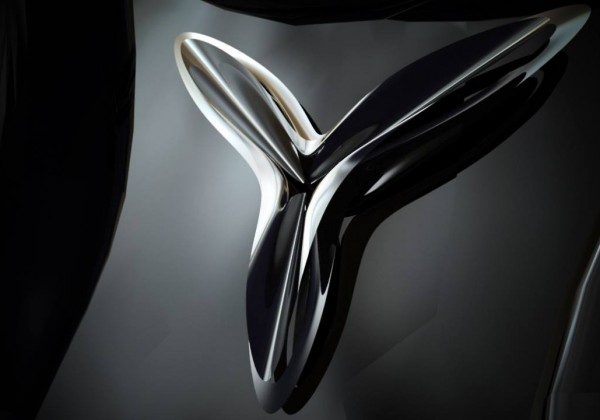 © FORMAKERS INTERVIEWS / Davide Del Giudice
La mia passione per il design computazionale, ci tengo a definirlo così perchè l'architettura parametrica non esiste ma solo i software possono essere definiti parametrici, è nata dopo un viaggio d'istruzione alla Sci_arc di Los Angeles e in seguito vitando l'Architectural Association di Londra l'interesse per questo tipo di design si è consolidato portandomi a viaggiare per conoscere cosa c'era fuori dall'italia e a seguire workshop centrati sull'utilizzo di software parametrici./////////////////////////////////////////////////////////////////////////////////////3- EN: WHAT HAS BEEN YOUR RELATIONSHIP WITH THE ITALIAN ACADEMIC ENVIRONMENT AND HOW DID YOU START DEALING WITH RESEARCH? IN SHORT, HOW YOUR PASSION FOR PARAMETRIC ARCHITECTURE BORN?
I was assistant to the design studio led by Prof.Roberto Apostolo in the design of a skyscraper at Porta Susa in Turin and assistant laboratory of Architectural Composition led by prof.Cesare Griffa for the redevelopment of an abandoned area in Turin. During the summer school Prototyping the City that took place during the event of the Turin World Design Capital together with Columbia University in New York and the Architectural Association in London I was the designer of the Zero configuration, an installation to accommodate students during the summer school and I was assistant tutor for the final design of the pavilion built at the OGR of Turin (OGR). During my thesis I founded with some fellow students a student association called A + Surface with the purpose of spreading the architectural research and organize events and workshops.
My passion for the computational design, I want to call it that because the parametric architecture does not exist but only the software can be defined parametric, was born after an educational trip to Sci_arc in Los Angeles and later visiting the Architectural Association in London my interest in this type of design has been consolidated leading me to travel to know what was out of Italy, and to follow the workshop centered on the use of parametric software.////////////////////////////////////////////////////////////////////////////////////////////////////////////////////////////////
4- IT: NEI TUOI LAVORI DOV'E' IL LIMITE TRA ARCHITETTURA E TECNICA DIGITALE?
Il limite c'è e lo vediamo ogni giorno, ci dobbiamo scontrare con la realizzabilità del prodotto e quindi dobbiamo tradurre le nostre geometrie complesse in geometrie più semplici quindi planari, a singola o doppia curvatura. La prototipazione rapida 3D che utiliizza materiali resistenti come leghe metalliche o resine resistenti spinge questo limite oltre gli standard a cui siamo abituati ma in termini di scala architettonica siamo ancora lontani dal poter dire che possiamo tradurre e stampare il nostro modello digitale in un modello concreto e reale.////////////////////////////////////////////////////////////4- EN: IN YOUR WORK WHERE DOES THE BOUNDARY BETWEEN ARCHITECTURE AND DIGITAL ENGINEERING START?
The limit is there and we see it every day, we must come to terms with the feasibility of the product and so we have to translate our complex geometries in planar geometries in simple, single or double curvature.
© FORMAKERS INTERVIEWS / Davide Del Giudice
La mia passione per il design computazionale, ci tengo a definirlo così perchè l'architettura parametrica non esiste ma solo i software possono essere definiti parametrici, è nata dopo un viaggio d'istruzione alla Sci_arc di Los Angeles e in seguito vitando l'Architectural Association di Londra l'interesse per questo tipo di design si è consolidato portandomi a viaggiare per conoscere cosa c'era fuori dall'italia e a seguire workshop centrati sull'utilizzo di software parametrici./////////////////////////////////////////////////////////////////////////////////////3- EN: WHAT HAS BEEN YOUR RELATIONSHIP WITH THE ITALIAN ACADEMIC ENVIRONMENT AND HOW DID YOU START DEALING WITH RESEARCH? IN SHORT, HOW YOUR PASSION FOR PARAMETRIC ARCHITECTURE BORN?
I was assistant to the design studio led by Prof.Roberto Apostolo in the design of a skyscraper at Porta Susa in Turin and assistant laboratory of Architectural Composition led by prof.Cesare Griffa for the redevelopment of an abandoned area in Turin. During the summer school Prototyping the City that took place during the event of the Turin World Design Capital together with Columbia University in New York and the Architectural Association in London I was the designer of the Zero configuration, an installation to accommodate students during the summer school and I was assistant tutor for the final design of the pavilion built at the OGR of Turin (OGR). During my thesis I founded with some fellow students a student association called A + Surface with the purpose of spreading the architectural research and organize events and workshops.
My passion for the computational design, I want to call it that because the parametric architecture does not exist but only the software can be defined parametric, was born after an educational trip to Sci_arc in Los Angeles and later visiting the Architectural Association in London my interest in this type of design has been consolidated leading me to travel to know what was out of Italy, and to follow the workshop centered on the use of parametric software.////////////////////////////////////////////////////////////////////////////////////////////////////////////////////////////////
4- IT: NEI TUOI LAVORI DOV'E' IL LIMITE TRA ARCHITETTURA E TECNICA DIGITALE?
Il limite c'è e lo vediamo ogni giorno, ci dobbiamo scontrare con la realizzabilità del prodotto e quindi dobbiamo tradurre le nostre geometrie complesse in geometrie più semplici quindi planari, a singola o doppia curvatura. La prototipazione rapida 3D che utiliizza materiali resistenti come leghe metalliche o resine resistenti spinge questo limite oltre gli standard a cui siamo abituati ma in termini di scala architettonica siamo ancora lontani dal poter dire che possiamo tradurre e stampare il nostro modello digitale in un modello concreto e reale.////////////////////////////////////////////////////////////4- EN: IN YOUR WORK WHERE DOES THE BOUNDARY BETWEEN ARCHITECTURE AND DIGITAL ENGINEERING START?
The limit is there and we see it every day, we must come to terms with the feasibility of the product and so we have to translate our complex geometries in planar geometries in simple, single or double curvature.
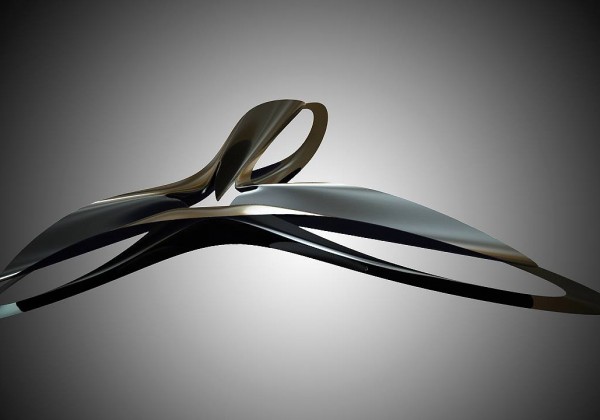 © FORMAKERS INTERVIEWS / Davide Del Giudice Rapid prototyping 3D using resistant materials such as metal alloys or resins resistant pushes the limit beyond the standards we are used to but in terms of architectural scale we are still far from being able to say that we can translate and print our digital model into a concrete model and real.
5- IT: C'E' MOLTO INTERESSE PER LA BIOARCHITETTURA ED I BIOMATERIALI.IN CHE MODO SI POTRA' IN FUTURO LEGARE LA BIOMIMETICA CIOè I PROCESSI BIOLOGICI AI PROCESSI DIGITALI?
La Biomimetica è lo studio dei processi biologici e biomeccanici della natura, che viene vista come mentore della progettazione di artefatti tecnici. La natura nell'arco del tempo ha saputo selezionare ciò che era più efficente di termini di forma, struttura e resistenza. Applicare la Biomimetica in Architettura significa sicuramente vedere evolvere l'Architettura e allo stesso tempo tramite i processi digitali si potrebbero esplorare forme finora sconosciute che meglio si adattano a particolari condizioni climatiche o a nuovi scenari emergenti. Il mondo in cui viviamo è sempre più inteso come il risultato emergente di sistemi complessi. La ricerca della complessità attraverso l'applicazione di sistemi autoorganizzati ci aiuta a capire come i fenomeni in natura possono funzionare alle varie scale. Di conseguenza esplorando la natura e il funzionamento dei sistemi complessi potremo applicare le scoperte al design. Lo sviluppo di metodologie progettuali non lineari comporta un radicale cambiamenti nel processo di progettazione architettonica, quindi ad una evoluzione e quindi ad un consistente miglioramento.////////////////////////////////////////////////////////////////////////////5- EN: THERE IS A BIG INTEREST IN THE BIO-ARCHITECTURE AND IN BIOMATERIALS.
© FORMAKERS INTERVIEWS / Davide Del Giudice Rapid prototyping 3D using resistant materials such as metal alloys or resins resistant pushes the limit beyond the standards we are used to but in terms of architectural scale we are still far from being able to say that we can translate and print our digital model into a concrete model and real.
5- IT: C'E' MOLTO INTERESSE PER LA BIOARCHITETTURA ED I BIOMATERIALI.IN CHE MODO SI POTRA' IN FUTURO LEGARE LA BIOMIMETICA CIOè I PROCESSI BIOLOGICI AI PROCESSI DIGITALI?
La Biomimetica è lo studio dei processi biologici e biomeccanici della natura, che viene vista come mentore della progettazione di artefatti tecnici. La natura nell'arco del tempo ha saputo selezionare ciò che era più efficente di termini di forma, struttura e resistenza. Applicare la Biomimetica in Architettura significa sicuramente vedere evolvere l'Architettura e allo stesso tempo tramite i processi digitali si potrebbero esplorare forme finora sconosciute che meglio si adattano a particolari condizioni climatiche o a nuovi scenari emergenti. Il mondo in cui viviamo è sempre più inteso come il risultato emergente di sistemi complessi. La ricerca della complessità attraverso l'applicazione di sistemi autoorganizzati ci aiuta a capire come i fenomeni in natura possono funzionare alle varie scale. Di conseguenza esplorando la natura e il funzionamento dei sistemi complessi potremo applicare le scoperte al design. Lo sviluppo di metodologie progettuali non lineari comporta un radicale cambiamenti nel processo di progettazione architettonica, quindi ad una evoluzione e quindi ad un consistente miglioramento.////////////////////////////////////////////////////////////////////////////5- EN: THERE IS A BIG INTEREST IN THE BIO-ARCHITECTURE AND IN BIOMATERIALS.
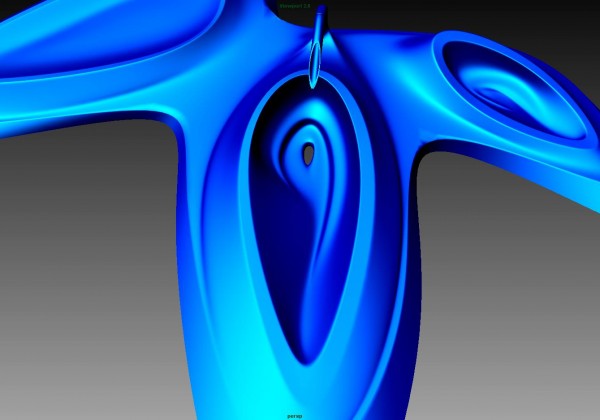 © FORMAKERS INTERVIEWS / Davide Del Giudice IN WHICH WAY COULD IN THE FUTURE BIOMIMETICS BE LINKED TO DIGITAL PROCESSES?
The Biomimetics is the study of biological processes and biomechanical in nature, which is seen as a mentor for the design of technical artifacts. The nature over time has been able to select what was most efficient in terms of form, structure and strength. Apply Biomimetics in Architecture means definitely to see evolve the architecture and at the same time using digital processes we could explore unknown forms that are best suited to specific climatic conditions or new emerging scenarios. The world we live in is increasingly understood as the result of emergent complex systems. The research of complexity through the application of self-organized systems helps us to understand how the phenomena in nature can operate at different scales. As a result of exploring the nature and the operation of complex systems we can apply the discoveries to design. The development of non linear design methodologies involves a radical change in the architectural design process, then an evolution and therefore to a substantial improvement.//////////////////////////////////////////////////
6- IT: SECONDO TE L'ARCHITETTURA PARAMETRICA CHE USA FATTORI AMBIENTALI PER CREARE FORME E PROGETTI IN ARMONIA CON L'AMBIENTE, PUO' ESSERE UNA POTENZIALE RICERCA PER IL FUTURO?
Credo fortemente in questo e dopo aver visto i risultati del ICD-ITKE Research Pavilion 2013-14 dell'Università di Stoccarda ne sono ancora più convinto. Da anni in questa università esplorano nuovi territori di ricerca nell'ambito di padiglioni temporanei che hanno come starting point lo studio dei comportamenti di strutture leggere in natura e negli insetti.
Durante la ricerca su di un insetto chiamato Elytron hanno scoperto che il guscio protettivo per le ali e l'addome di questi scarabei è un modello adatto per costruzioni ad alta efficenza. Le prestazioni di queste strutture leggere si basa sulla morfologia geometrica di un sistema a doppio strato e le propietà meccaniche del composto in fibra naturale.
© FORMAKERS INTERVIEWS / Davide Del Giudice IN WHICH WAY COULD IN THE FUTURE BIOMIMETICS BE LINKED TO DIGITAL PROCESSES?
The Biomimetics is the study of biological processes and biomechanical in nature, which is seen as a mentor for the design of technical artifacts. The nature over time has been able to select what was most efficient in terms of form, structure and strength. Apply Biomimetics in Architecture means definitely to see evolve the architecture and at the same time using digital processes we could explore unknown forms that are best suited to specific climatic conditions or new emerging scenarios. The world we live in is increasingly understood as the result of emergent complex systems. The research of complexity through the application of self-organized systems helps us to understand how the phenomena in nature can operate at different scales. As a result of exploring the nature and the operation of complex systems we can apply the discoveries to design. The development of non linear design methodologies involves a radical change in the architectural design process, then an evolution and therefore to a substantial improvement.//////////////////////////////////////////////////
6- IT: SECONDO TE L'ARCHITETTURA PARAMETRICA CHE USA FATTORI AMBIENTALI PER CREARE FORME E PROGETTI IN ARMONIA CON L'AMBIENTE, PUO' ESSERE UNA POTENZIALE RICERCA PER IL FUTURO?
Credo fortemente in questo e dopo aver visto i risultati del ICD-ITKE Research Pavilion 2013-14 dell'Università di Stoccarda ne sono ancora più convinto. Da anni in questa università esplorano nuovi territori di ricerca nell'ambito di padiglioni temporanei che hanno come starting point lo studio dei comportamenti di strutture leggere in natura e negli insetti.
Durante la ricerca su di un insetto chiamato Elytron hanno scoperto che il guscio protettivo per le ali e l'addome di questi scarabei è un modello adatto per costruzioni ad alta efficenza. Le prestazioni di queste strutture leggere si basa sulla morfologia geometrica di un sistema a doppio strato e le propietà meccaniche del composto in fibra naturale.
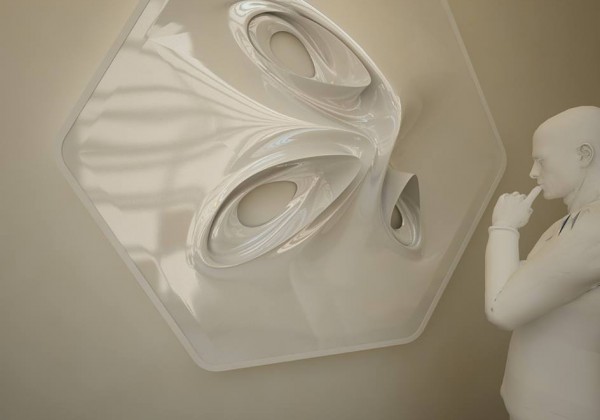 © FORMAKERS INTERVIEWS / Davide Del Giudice La caratteristica anisotropa del materiale, fibre di chitina annegate in una matrice proteica, consente di avere proprietà dei materiali differenziati localmente. Questo viene tradotto in regole di progettazione per morfologie strutturali che hanno differenti articolazioni geometriche e distribuzioni di materiali molto efficenti.
Il tutto si traduce in geometrie complesse con una migliore performance strutturale e un miglioramento dei costi sui materiali di produzione.////////////////////////////////////////////////////////////6- EN: DO YOU THINK THAT THE PARAMETRIC ARCHITECTURE -WHICH USES ENVIRONMENTAL FACTORS TO CREATE FORMS AND PROJECTS THAT ARE IN SYNERGIES WITH THE ENVIRONMENT - MAY BE A POTENTIAL ISSUE OF RESEARCH FOR THE FUTURE?
I strongly believe in this and after seeing the results of the ICD ITKE Research Pavilion at the University of Stuttgart 2013-14 I am more convinced. For years in this university they explorate new areas of research in the field of temporary pavilions that have as their starting point the study of the behavior of light structures in nature and in insects.
During the research of an insect called Elytron they found that the protective shell for the wings and abdomen of these beetles is a model suitable for buildings with high efficiency. The performance of these lightweight structures is based on the geometrical morphology of a double layer system and the mechanical properties of the compound made of natural fiber. The characteristic of the anisotropic material, chitin fibers embedded in a protein matrix, allows to have differentiated properties of the materials locally. This is translated into design rules for structural morphologies that have different geometrical articulation and material distribution very efficient.
All this translates into complex geometries with improved structural performance and an improvement in material costs of production.
© FORMAKERS INTERVIEWS / Davide Del Giudice La caratteristica anisotropa del materiale, fibre di chitina annegate in una matrice proteica, consente di avere proprietà dei materiali differenziati localmente. Questo viene tradotto in regole di progettazione per morfologie strutturali che hanno differenti articolazioni geometriche e distribuzioni di materiali molto efficenti.
Il tutto si traduce in geometrie complesse con una migliore performance strutturale e un miglioramento dei costi sui materiali di produzione.////////////////////////////////////////////////////////////6- EN: DO YOU THINK THAT THE PARAMETRIC ARCHITECTURE -WHICH USES ENVIRONMENTAL FACTORS TO CREATE FORMS AND PROJECTS THAT ARE IN SYNERGIES WITH THE ENVIRONMENT - MAY BE A POTENTIAL ISSUE OF RESEARCH FOR THE FUTURE?
I strongly believe in this and after seeing the results of the ICD ITKE Research Pavilion at the University of Stuttgart 2013-14 I am more convinced. For years in this university they explorate new areas of research in the field of temporary pavilions that have as their starting point the study of the behavior of light structures in nature and in insects.
During the research of an insect called Elytron they found that the protective shell for the wings and abdomen of these beetles is a model suitable for buildings with high efficiency. The performance of these lightweight structures is based on the geometrical morphology of a double layer system and the mechanical properties of the compound made of natural fiber. The characteristic of the anisotropic material, chitin fibers embedded in a protein matrix, allows to have differentiated properties of the materials locally. This is translated into design rules for structural morphologies that have different geometrical articulation and material distribution very efficient.
All this translates into complex geometries with improved structural performance and an improvement in material costs of production.
 © FORMAKERS INTERVIEWS / Davide Del Giudice///////////////////////////////////////////////////////////////////7- IT: OLTRE ALL'AMBIENTE, UN PUNTO DI FORZA DELLA TUA RICERCA PUò ESSERE LA COLLABORAZIONE INTERDISCIPLINARE CON I FASHION STYLIST. QUANTO E COME COLLABORANO DUE MONDI DIVERSI COME MODA E ARCHITETTURA?
Oltre all’ambiente un punto di forza della tua ricerca può essere la collaborazione interdisciplinare con i fashion stylist . Quanto e come collaborano due mondi diversi come Moda e Architettura?
I due mondi non sono molto diversi se li pensiamo in termini di design. Sia per un capo , per un oggetto di design o per un progetto architettonico c'è un processo progettuale che ha come scopo l'adattamento al corpo umano. Lo spazio che viviamo all'interno delle nostre architetture, la funzionalità e l'estetica di un oggetto e il comfort di un abito sono tutte dimensioni di percezione di spazio e materia alle quali il nostro corpo impara ad adattarsi. In effetti l'archittettura è come un abito che indossiamo, una nostra seconda pelle. Credo che molti stilisti abbiano capito l'importanza di studi interdisciplinari in between tra il design computazionale e lo studio dei processi dei materiali e penso che ci siano già degli ottimi risultati in termini di coerenza geometrica, performance dei tessuti e dei materiali usati e eleganza nella composizione dell'abito stesso. //////////////////////////////////////////////////////////////////7- EN: BEYOND THE ENVIRONMENT, A HIGHLIGHT OF YOUR RESEARCH CAN BE INTERDISCIPLINARY COLLABORATION WITH FASHION STYLISTS. TO WHAT EXTENT AND HOW DO TWO DIFFERENT WORLDS LIKE FASHION AND ARCHITECTURE COOPERATE?
The two worlds are not very different if we think in terms of design. Whether for a dress, for a design object or an architectural project there is a process that aims to adapt to the human body. The space that we live within our architecture, the functionality and aesthetics of an object and the comfort of a dress are all dimensions of perception of space and matter to which our body learns to adapt.
© FORMAKERS INTERVIEWS / Davide Del Giudice///////////////////////////////////////////////////////////////////7- IT: OLTRE ALL'AMBIENTE, UN PUNTO DI FORZA DELLA TUA RICERCA PUò ESSERE LA COLLABORAZIONE INTERDISCIPLINARE CON I FASHION STYLIST. QUANTO E COME COLLABORANO DUE MONDI DIVERSI COME MODA E ARCHITETTURA?
Oltre all’ambiente un punto di forza della tua ricerca può essere la collaborazione interdisciplinare con i fashion stylist . Quanto e come collaborano due mondi diversi come Moda e Architettura?
I due mondi non sono molto diversi se li pensiamo in termini di design. Sia per un capo , per un oggetto di design o per un progetto architettonico c'è un processo progettuale che ha come scopo l'adattamento al corpo umano. Lo spazio che viviamo all'interno delle nostre architetture, la funzionalità e l'estetica di un oggetto e il comfort di un abito sono tutte dimensioni di percezione di spazio e materia alle quali il nostro corpo impara ad adattarsi. In effetti l'archittettura è come un abito che indossiamo, una nostra seconda pelle. Credo che molti stilisti abbiano capito l'importanza di studi interdisciplinari in between tra il design computazionale e lo studio dei processi dei materiali e penso che ci siano già degli ottimi risultati in termini di coerenza geometrica, performance dei tessuti e dei materiali usati e eleganza nella composizione dell'abito stesso. //////////////////////////////////////////////////////////////////7- EN: BEYOND THE ENVIRONMENT, A HIGHLIGHT OF YOUR RESEARCH CAN BE INTERDISCIPLINARY COLLABORATION WITH FASHION STYLISTS. TO WHAT EXTENT AND HOW DO TWO DIFFERENT WORLDS LIKE FASHION AND ARCHITECTURE COOPERATE?
The two worlds are not very different if we think in terms of design. Whether for a dress, for a design object or an architectural project there is a process that aims to adapt to the human body. The space that we live within our architecture, the functionality and aesthetics of an object and the comfort of a dress are all dimensions of perception of space and matter to which our body learns to adapt.
 © FORMAKERS INTERVIEWS / Davide Del Giudice In fact, the architecture is like a dress we wear, our second skin. I believe that many designers have understood the importance of interdisciplinary studies in between of computational design and the research of the processes of the materials and I think there are already some good results in terms of its geometry, performance fabrics and materials and elegance .
8- IT: ULTIMA DOMANDA: si stanno sperimentando nuove proposte per costruire su Marte o sulla Luna. Ma al di la di queste grandi sperimentazioni pensi che tramite le Stampanti 3D e altre macchine a controllo numerico possiamo risolvere grandi problemi sociali come la costruzione di case in paesi in via di sviluppo? Per esempio l’ Africa . Quali sono le idee più interessanti o più convincenti che hai incontrato e quali secondo te possono essere per il futuro?
Sicuramente potranno aiutare le popolazioni in via di sviluppo, ma in questo caso scende in campo la politica e tutto ciò ne concerne quindi sono molto scettico. Una soluzione progettuale in cui credo molto è l'autocostruzione dove le popolazioni locali imparano a produrre i materiali che servono per costruire e imparano le tecniche e le tecnologie per produrre le propie abitazioni. Il progetto della casa completamente stampata in 3D del gruppo WASP lo trovo molto interessante, mi piace anche molto il design che ricorda una geometria vernacolare e che al tempo stesso è innovativa ed efficente. In futuro credo che ci sarà molto fermento per quanto riguarda l'utilizzo di robots come strumento per la costruzione di geometrie complesse, l'architettura è una tecnologia e un'arte al servizio dell'uomo e si adatta evolvendosi agli scenari di vita contemporanei. il progettista del futuro sarà il progettista del presente che saprà prevedere questo cambiamento in atto.//////////////////////////////////////////////////////8 - EN: LAST QUESTION
Definitely will be able to help people in the developing countries, but in this case falls in the political field and everything it relates to so I am very skeptical.
© FORMAKERS INTERVIEWS / Davide Del Giudice In fact, the architecture is like a dress we wear, our second skin. I believe that many designers have understood the importance of interdisciplinary studies in between of computational design and the research of the processes of the materials and I think there are already some good results in terms of its geometry, performance fabrics and materials and elegance .
8- IT: ULTIMA DOMANDA: si stanno sperimentando nuove proposte per costruire su Marte o sulla Luna. Ma al di la di queste grandi sperimentazioni pensi che tramite le Stampanti 3D e altre macchine a controllo numerico possiamo risolvere grandi problemi sociali come la costruzione di case in paesi in via di sviluppo? Per esempio l’ Africa . Quali sono le idee più interessanti o più convincenti che hai incontrato e quali secondo te possono essere per il futuro?
Sicuramente potranno aiutare le popolazioni in via di sviluppo, ma in questo caso scende in campo la politica e tutto ciò ne concerne quindi sono molto scettico. Una soluzione progettuale in cui credo molto è l'autocostruzione dove le popolazioni locali imparano a produrre i materiali che servono per costruire e imparano le tecniche e le tecnologie per produrre le propie abitazioni. Il progetto della casa completamente stampata in 3D del gruppo WASP lo trovo molto interessante, mi piace anche molto il design che ricorda una geometria vernacolare e che al tempo stesso è innovativa ed efficente. In futuro credo che ci sarà molto fermento per quanto riguarda l'utilizzo di robots come strumento per la costruzione di geometrie complesse, l'architettura è una tecnologia e un'arte al servizio dell'uomo e si adatta evolvendosi agli scenari di vita contemporanei. il progettista del futuro sarà il progettista del presente che saprà prevedere questo cambiamento in atto.//////////////////////////////////////////////////////8 - EN: LAST QUESTION
Definitely will be able to help people in the developing countries, but in this case falls in the political field and everything it relates to so I am very skeptical.
 © FORMAKERS INTERVIEWS / Davide Del Giudice A design solution that I think is DIY where local people learn to produce materials that are used to build and learn the techniques and technologies to produce up its own housing. The design of the house completely molded in 3D by group WASP I find it very interesting, I also like the design very reminiscent of a vernacular geometry and at the same time is innovative and efficient. In the future I think there will be much excitement regarding the use of robots as a tool for the construction of complex geometries, the architecture is an art and technology at the service of human and adapts to evolving scenarios of contemporary life. the designer of the future will be the designer of the present that will provide this ongoing change..
© FORMAKERS INTERVIEWS / Davide Del Giudice A design solution that I think is DIY where local people learn to produce materials that are used to build and learn the techniques and technologies to produce up its own housing. The design of the house completely molded in 3D by group WASP I find it very interesting, I also like the design very reminiscent of a vernacular geometry and at the same time is innovative and efficient. In the future I think there will be much excitement regarding the use of robots as a tool for the construction of complex geometries, the architecture is an art and technology at the service of human and adapts to evolving scenarios of contemporary life. the designer of the future will be the designer of the present that will provide this ongoing change..
 © FORMAKERS INTERVIEWS / Davide Del Giudice
© FORMAKERS INTERVIEWS / Davide Del Giudice
 © FORMAKERS INTERVIEWS / Davide Del Giudice
© FORMAKERS INTERVIEWS / Davide Del Giudice
 © FORMAKERS INTERVIEWS / Davide Del Giudice
© FORMAKERS INTERVIEWS / Davide Del Giudice
 © FORMAKERS INTERVIEWS / Davide Del Giudice
© FORMAKERS INTERVIEWS / Davide Del Giudice
 © FORMAKERS INTERVIEWS / Davide Del Giudice
© FORMAKERS INTERVIEWS / Davide Del Giudice
 © FORMAKERS INTERVIEWS / Davide Del Giudice
© FORMAKERS INTERVIEWS / Davide Del Giudice
 © FORMAKERS INTERVIEWS / Davide Del Giudice
© FORMAKERS INTERVIEWS / Davide Del Giudice
 © FORMAKERS INTERVIEWS / Davide Del Giudice
© FORMAKERS INTERVIEWS / Davide Del Giudice
 © FORMAKERS INTERVIEWS / Davide Del Giudice
© FORMAKERS INTERVIEWS / Davide Del Giudice
FM INTERVIEWS / Davide Del Giudice
Posted in Events_Interviews - Formakers Interview by * FORMAKERS
1 - CHI E' DAVIDE DEL GIUDICE? Sono un architetto laureato al Politecnico di Torino e ho avuto diverse esperienze formative in Italia, in Europa, in Russia e in California. Sono co-fondatore di Co-de-iT,insieme all'Arch.Andrea Graziano e al prof.Alessio Erioli, un cluster di ricercatori che esplora il design computazionale e nuovi metodi per l'insegnamento. Attualmente vivo a Londra e sono un Senior Architect dello studio Zaha Hadid Architect, nel tempo "libero" mi occupo dei miei progetti personali nel campo del furniture design. 1- EN: DAVIDE DEL GIUDICE? I'm an architect graduated from the Polytechnic of Turin and I had different experiences in Italy, in Europe, in Russia and in California. © FORMAKERS INTERVIEWS / Davide Del Giudice
© FORMAKERS INTERVIEWS / Davide Del Giudice © FORMAKERS INTERVIEWS / Davide Del Giudice
© FORMAKERS INTERVIEWS / Davide Del Giudice © FORMAKERS INTERVIEWS / Davide Del Giudice
© FORMAKERS INTERVIEWS / Davide Del Giudice © FORMAKERS INTERVIEWS / Davide Del Giudice
© FORMAKERS INTERVIEWS / Davide Del Giudice © FORMAKERS INTERVIEWS / Davide Del Giudice
© FORMAKERS INTERVIEWS / Davide Del Giudice © FORMAKERS INTERVIEWS / Davide Del Giudice
© FORMAKERS INTERVIEWS / Davide Del Giudice © FORMAKERS INTERVIEWS / Davide Del Giudice
© FORMAKERS INTERVIEWS / Davide Del Giudice © FORMAKERS INTERVIEWS / Davide Del Giudice
© FORMAKERS INTERVIEWS / Davide Del Giudice © FORMAKERS INTERVIEWS / Davide Del Giudice
© FORMAKERS INTERVIEWS / Davide Del Giudice © FORMAKERS INTERVIEWS / Davide Del Giudice
© FORMAKERS INTERVIEWS / Davide Del Giudice
 © FORMAKERS INTERVIEWS / Davide Del Giudice
© FORMAKERS INTERVIEWS / Davide Del Giudice
 © FORMAKERS INTERVIEWS / Davide Del Giudice
© FORMAKERS INTERVIEWS / Davide Del Giudice
 © FORMAKERS INTERVIEWS / Davide Del Giudice
© FORMAKERS INTERVIEWS / Davide Del Giudice
 © FORMAKERS INTERVIEWS / Davide Del Giudice
© FORMAKERS INTERVIEWS / Davide Del Giudice
 © FORMAKERS INTERVIEWS / Davide Del Giudice
© FORMAKERS INTERVIEWS / Davide Del Giudice
 © FORMAKERS INTERVIEWS / Davide Del Giudice
© FORMAKERS INTERVIEWS / Davide Del Giudice
 © FORMAKERS INTERVIEWS / Davide Del Giudice
© FORMAKERS INTERVIEWS / Davide Del Giudice
 © FORMAKERS INTERVIEWS / Davide Del Giudice
© FORMAKERS INTERVIEWS / Davide Del Giudice
Comments
No comments
Sign in »



